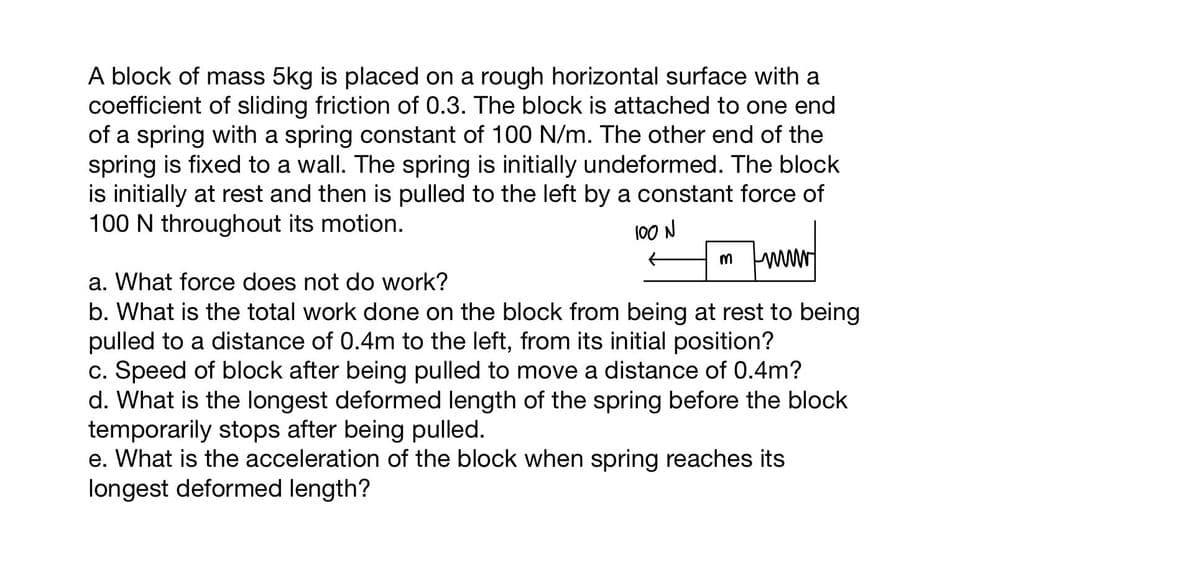A block of mass 5kg is placed on a rough horizontal surface with a coefficient of sliding friction of 0.3. The block is attached to one end of a spring with a spring constant of 100 N/m. The other end of the spring is fixed to a wall. The spring is initially undeformed. The block is initially at rest and then is pulled to the left by a constant force of 100 N throughout its motion. 100 N m wwwww a. What force does not do work? b. What is the total work done on the block from being at rest to being pulled to a distance of 0.4m to the left, from its initial position? c. Speed of block after being pulled to move a distance of 0.4m? d. What is the longest deformed length of the spring before the block temporarily stops after being pulled. e. What is the acceleration of the block when spring reaches its longest deformed length?
A block of mass 5kg is placed on a rough horizontal surface with a coefficient of sliding friction of 0.3. The block is attached to one end of a spring with a spring constant of 100 N/m. The other end of the spring is fixed to a wall. The spring is initially undeformed. The block is initially at rest and then is pulled to the left by a constant force of 100 N throughout its motion. 100 N m wwwww a. What force does not do work? b. What is the total work done on the block from being at rest to being pulled to a distance of 0.4m to the left, from its initial position? c. Speed of block after being pulled to move a distance of 0.4m? d. What is the longest deformed length of the spring before the block temporarily stops after being pulled. e. What is the acceleration of the block when spring reaches its longest deformed length?
Elements Of Electromagnetics
7th Edition
ISBN:9780190698614
Author:Sadiku, Matthew N. O.
Publisher:Sadiku, Matthew N. O.
ChapterMA: Math Assessment
Section: Chapter Questions
Problem 1.1MA
Related questions
Question
ANSWER D AND E ONLY. HANDWRITTEN THEN BOX THE FINAL ANSWERS

Transcribed Image Text:A block of mass 5kg is placed on a rough horizontal surface with a
coefficient of sliding friction of 0.3. The block is attached to one end
of a spring with a spring constant of 100 N/m. The other end of the
spring is fixed to a wall. The spring is initially undeformed. The block
is initially at rest and then is pulled to the left by a constant force of
100 N throughout its motion.
100 N
m www
a. What force does not do work?
b. What is the total work done on the block from being at rest to being
pulled to a distance of 0.4m to the left, from its initial position?
c. Speed of block after being pulled to move a distance of 0.4m?
d. What is the longest deformed length of the spring before the block
temporarily stops after being pulled.
e. What is the acceleration of the block when spring reaches its
longest deformed length?
Expert Solution
This question has been solved!
Explore an expertly crafted, step-by-step solution for a thorough understanding of key concepts.
Step by step
Solved in 3 steps with 3 images

Knowledge Booster
Learn more about
Need a deep-dive on the concept behind this application? Look no further. Learn more about this topic, mechanical-engineering and related others by exploring similar questions and additional content below.Recommended textbooks for you

Elements Of Electromagnetics
Mechanical Engineering
ISBN:
9780190698614
Author:
Sadiku, Matthew N. O.
Publisher:
Oxford University Press

Mechanics of Materials (10th Edition)
Mechanical Engineering
ISBN:
9780134319650
Author:
Russell C. Hibbeler
Publisher:
PEARSON

Thermodynamics: An Engineering Approach
Mechanical Engineering
ISBN:
9781259822674
Author:
Yunus A. Cengel Dr., Michael A. Boles
Publisher:
McGraw-Hill Education

Elements Of Electromagnetics
Mechanical Engineering
ISBN:
9780190698614
Author:
Sadiku, Matthew N. O.
Publisher:
Oxford University Press

Mechanics of Materials (10th Edition)
Mechanical Engineering
ISBN:
9780134319650
Author:
Russell C. Hibbeler
Publisher:
PEARSON

Thermodynamics: An Engineering Approach
Mechanical Engineering
ISBN:
9781259822674
Author:
Yunus A. Cengel Dr., Michael A. Boles
Publisher:
McGraw-Hill Education

Control Systems Engineering
Mechanical Engineering
ISBN:
9781118170519
Author:
Norman S. Nise
Publisher:
WILEY

Mechanics of Materials (MindTap Course List)
Mechanical Engineering
ISBN:
9781337093347
Author:
Barry J. Goodno, James M. Gere
Publisher:
Cengage Learning

Engineering Mechanics: Statics
Mechanical Engineering
ISBN:
9781118807330
Author:
James L. Meriam, L. G. Kraige, J. N. Bolton
Publisher:
WILEY